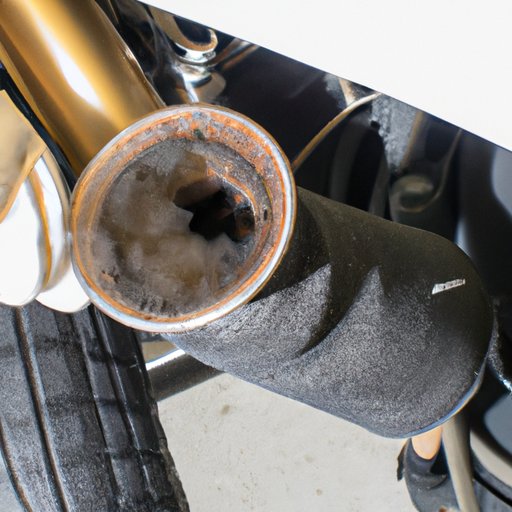
Introduction
A catalytic converter is an essential component of a vehicle’s exhaust system that helps reduce harmful emissions. Over time, this component can become clogged with debris, causing a decrease in your car’s performance. In this article, we will provide a step-by-step guide to cleaning your catalytic converter at home, explain why keeping it clean is important for your car’s health and emissions, and compare the pros and cons of cleaning it yourself versus hiring a professional. We will also recommend some products for effective cleaning and share tips for troubleshooting common catalytic converter issues.
5 Easy Steps to Clean Your Catalytic Converter and Improve Your Car’s Performance
Cleaning your catalytic converter is a relatively simple process that can help improve your car’s performance. Before you begin, make sure your car is turned off and the engine is cool. Here are the steps to follow:
- Locate the catalytic converter: The converter is typically found in the middle of the exhaust system underneath the car. It’s a metal box-shaped component with pipes running in and out of it.
- Inspect the converter: Check the converter for cracks, leaks or other physical damage. If you notice any damage, you may need to replace the component.
- Clean the converter: Use a specialized catalytic converter cleaner, such as Cataclean or CRC Guaranteed to Pass, to clean the converter. Follow the instructions on the label and pour the cleaner into your fuel tank. Drive your car for at least 15 minutes to allow the cleaner to run through the system.
- Repeat the process: Depending on the level of build-up in your converter, you may need to repeat this process a few times to get the desired results.
- Maintain your converter: Once your converter is clean, it’s important to maintain it by using a fuel injector cleaner every few months. This will help prevent build-up and extend the life of your converter.
When cleaning your catalytic converter, it’s important to use the right tools and cleaners to avoid damaging the component.
Why Cleaning Your Catalytic Converter is Important for Your Car’s Health
A dirty catalytic converter can negatively impact your car’s engine performance and emissions. Over time, the build-up of debris can clog the converter, causing a decrease in acceleration and fuel economy. This can also cause harmful emissions to increase, contributing to atmospheric pollution. Therefore, it’s important to regularly clean your converter to maintain your car’s health and reduce its environmental impact.
To keep your converter well-maintained, we recommend cleaning it every 30,000 to 50,000 miles, or as recommended by your car manufacturer.
DIY vs. Professional Cleaning: Which is Right for Your Catalytic Converter?
When it comes to cleaning your catalytic converter, you have two options: to do it yourself or to hire a professional mechanic. Both options have their pros and cons, and the decision depends on your preferences and skills.
DIY cleaning is a cheaper option that allows you to save time and money. You can purchase a cleaning kit at an auto parts store and follow the instructions to clean your converter at home. However, DIY cleaning may not be effective if your converter is severely clogged or damaged.
Hiring a professional mechanic can be more expensive, but it guarantees your converter will be cleaned effectively. A mechanic will have the expertise and professional equipment needed to diagnose and clean your converter. However, it’s important to research and choose a reputable mechanic to ensure quality work and avoid scams.
Ultimately, the decision to clean your catalytic converter yourself or with a professional is up to you and depends on your budget and preferences.
The Top 3 Products for Cleaning Your Catalytic Converter at Home
There are several effective products for cleaning your catalytic converter at home. Here are three options:
- Cataclean: This product is specifically designed to clean catalytic converters and contains a mix of detergents and cleaners that can dissolve carbon build-up. It’s easy to use and can be poured directly into your fuel tank.
- CRC Guaranteed to Pass: This cleaner is formulated with powerful detergents that can clean your fuel system, oxygen sensors, and catalytic converter. It’s safe for all gasoline engines and compatible with hybrid and turbocharged vehicles.
- Sea Foam Motor Treatment: This product is a popular choice for cleaning catalytic converters and other engine components. It contains a blend of petroleum-based cleaners that can dissolve carbon and other harmful deposits.
Before using any cleaner, make sure to read and follow the instructions on the label carefully. It’s also important to choose a product that is compatible with your vehicle’s engine and converter.
Troubleshooting Common Catalytic Converter Issues and How to Fix Them
Even with regular cleaning and maintenance, catalytic converters can experience problems. Here are some common issues and solutions:
- Check Engine Light: If your check engine light is on, it could be a sign of a catalytic converter problem. You can use a diagnostic code reader to identify the issue and use the appropriate cleaner to remove any build-up.
- Rattling Noise: A rattling noise from your converter could indicate a loose or damaged component. In this case, you may need to replace the converter.
- Poor Acceleration: If your car is experiencing poor acceleration or stalling, it could be a sign of a clogged converter. You can use a cleaning product to remove any blockages.
Conclusion
A clean catalytic converter is essential for a healthy engine and reduced emissions. Keeping it clean is simple and can be done yourself or with the help of a professional mechanic. Effective cleaning products are readily available, and regular maintenance can prevent common issues. By following the steps outlined in this article, you can ensure your converter is running smoothly and contributing to a cleaner environment.





